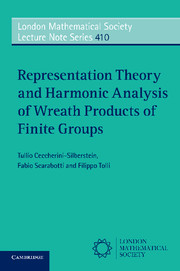2 - Wreath products of finite groups and their representation theory
Published online by Cambridge University Press: 05 January 2014
Summary
In this chapter, which constitutes the core of the book, we develop the representation theory of wreath products. Our exposition is inspired by the monographs of James and Kerber [38] and Huppert [35]. Howewer, our approach is more analytical and, in particular, we interpret the exponentiation and the composition actions in terms of actions on suitable rooted trees. This is done in Section 2.1.2. In Section 2.3 we describe the conjugacy classes of wreath products F ≀ G, with particular emphasis on groups of the form C2 ≀ G (Section 2.3.2), and F ≀ Sn (Section 2.3.3), and then in Section 2.4 we use the little group method (Theorem 1.3.11) to determine a complete list of irreducible representations of wreath products. Finally in Sections 2.5 and 2.6 we analyze the representation theory of groups of the form C2 ≀ G and F ≀ Sn, respectively. This yields, in particular, a clear description of the representations of finite lamplighter groups (Sections 2.5.1 and 2.5.2) as well as of the groups Sm ≀ Sn (Section 2.6.1).
Basic properties of wreath products of finite groups
2.1.1 Definitions
Let G and F be two finite groups and suppose that G acts on a finite set X. Denote by FX the set of all maps f : X → F. The set FX is a group under pointwise multiplication: (f • f′)(x) = f(x)f′(x) for all f, f′ ∈ FX and x ∈ X.
- Type
- Chapter
- Information
- Publisher: Cambridge University PressPrint publication year: 2014



